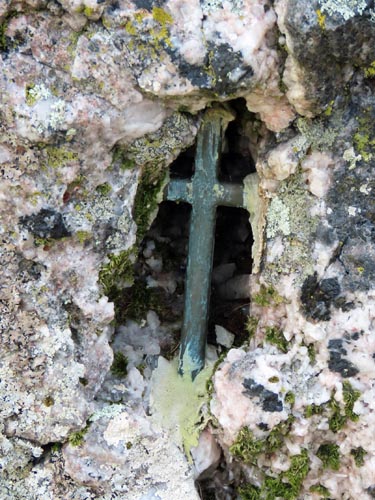| Traveller's Ford Cross |
 Location: Fixed
into the small crevice of a boulder in the Traveller's Ford area. Location: Fixed
into the small crevice of a boulder in the Traveller's Ford area.Grid Ref: Due to the fact that other similar crosses on the moor have been either stolen or damaged, we have decided not to publish the exact location of this cross. Map location: See above. Purpose: Unknown. Size: The cross measures 4⅝ inches (0.12 metres) high and 1⅝ inches (0.04 metres) across the arms. Information: There has been a little metal cross fixed into this boulder on and off for many years. We first heard about it around 15 or 20 years ago but when we visited the area the cross was found to be missing. Happily now, as of 2021, the cross is back in position. We've not been able to find out who put this cross out on the moor or their reason for doing so. If anyone can help with this information we'd be more than pleased to hear from you. Please contact either: maurice.daniel.007@gmail.com or Glenn.bearne@btinternet.com. This boulder and cross sits close to the ancient cross-moor route of the Lych Way, or the 'Way of the Dead'. This route runs from the hamlet of Bellever to the parish church at Lydford. In ancient times, prior to 1260, the parish of Lydford covered the majority of the north moor and a good portion of the south moor as well. When anyone from a village, hamlet or a tenement farm within the Lydford Parish died, the body would be required to be transported across the moor to be buried in the churchyard at Lydford, For someone from the Bellever and Postbridge areas this would entail a journey across open moorland of around 12 miles, which might be extended to around 18 miles during the wet season when all the flooded streams and rivers would need to be circumnavigated. The route was also used by the parishioners to attend their normal church services and, occasionally, the Stannary Court, also at Lydford.
Our thanks to Bob Noakes for bringing the fact that the cross has now been replaced to our attention. |